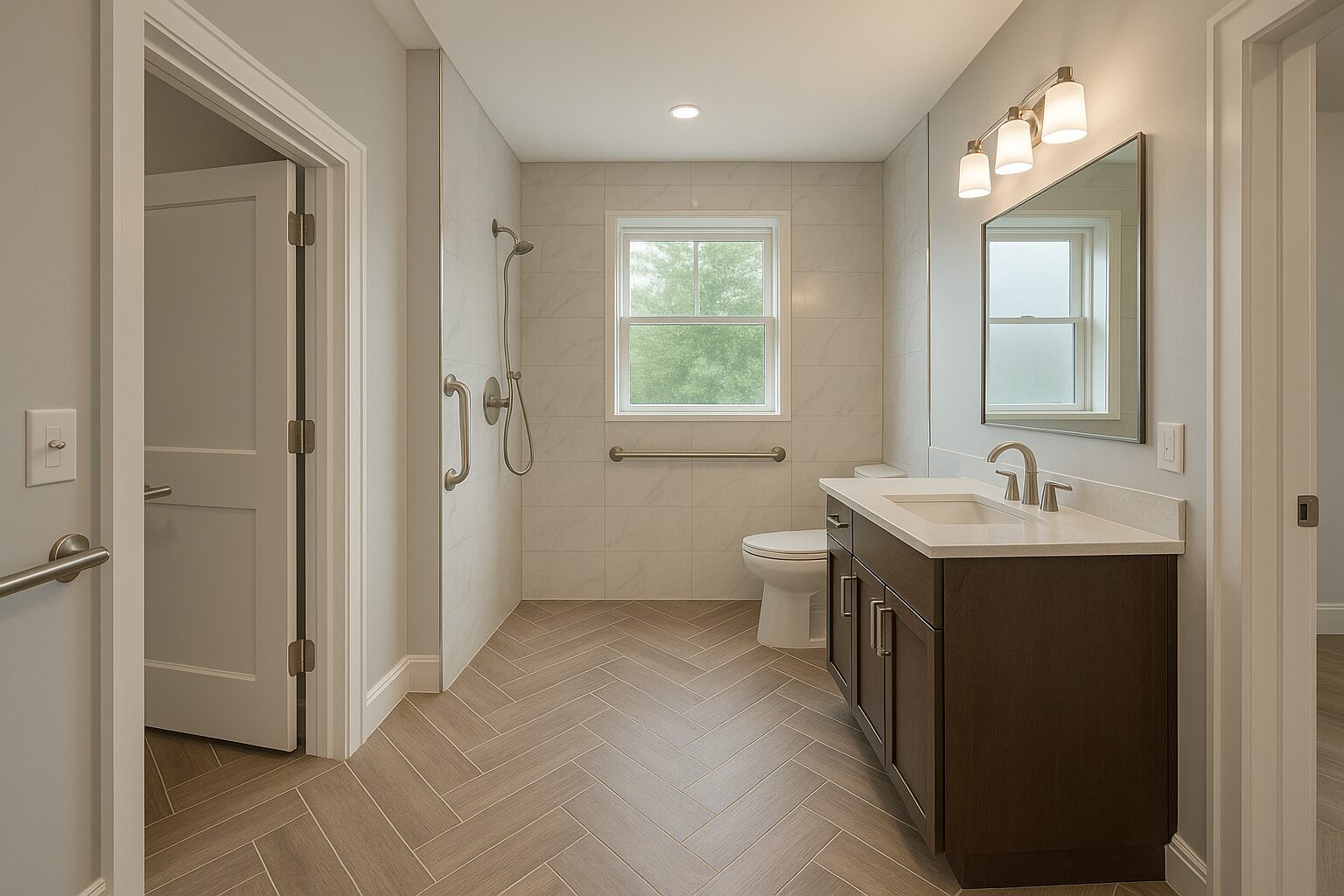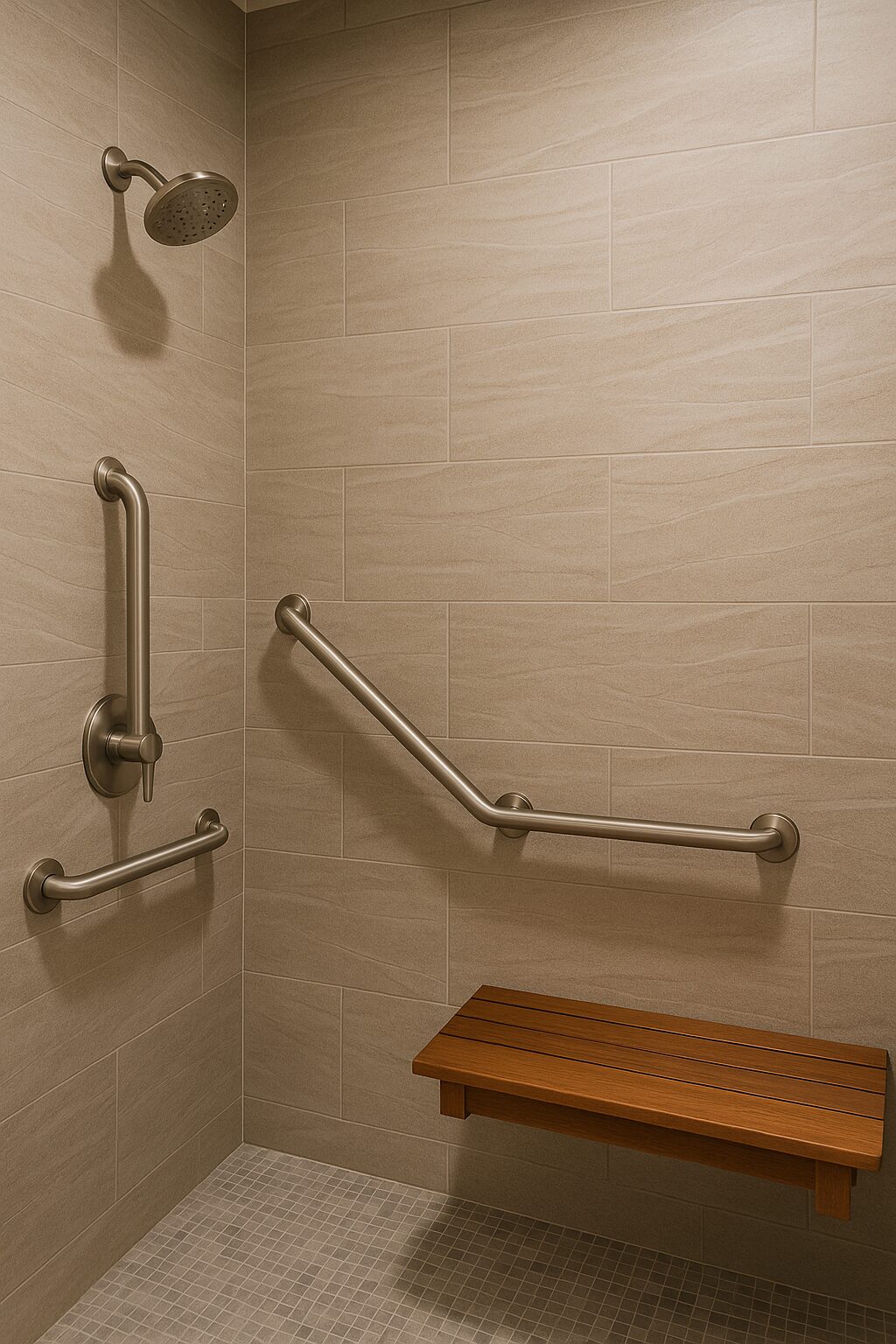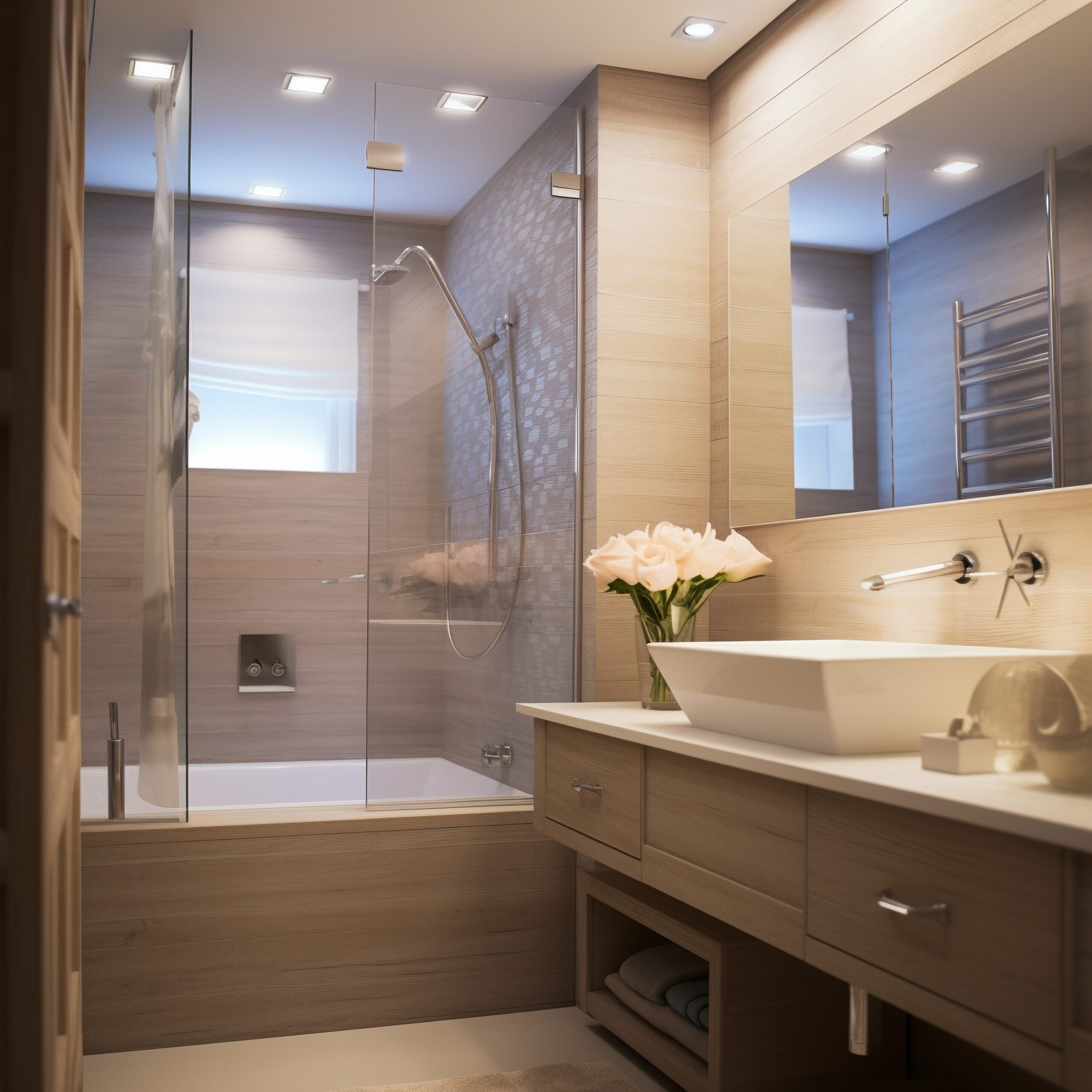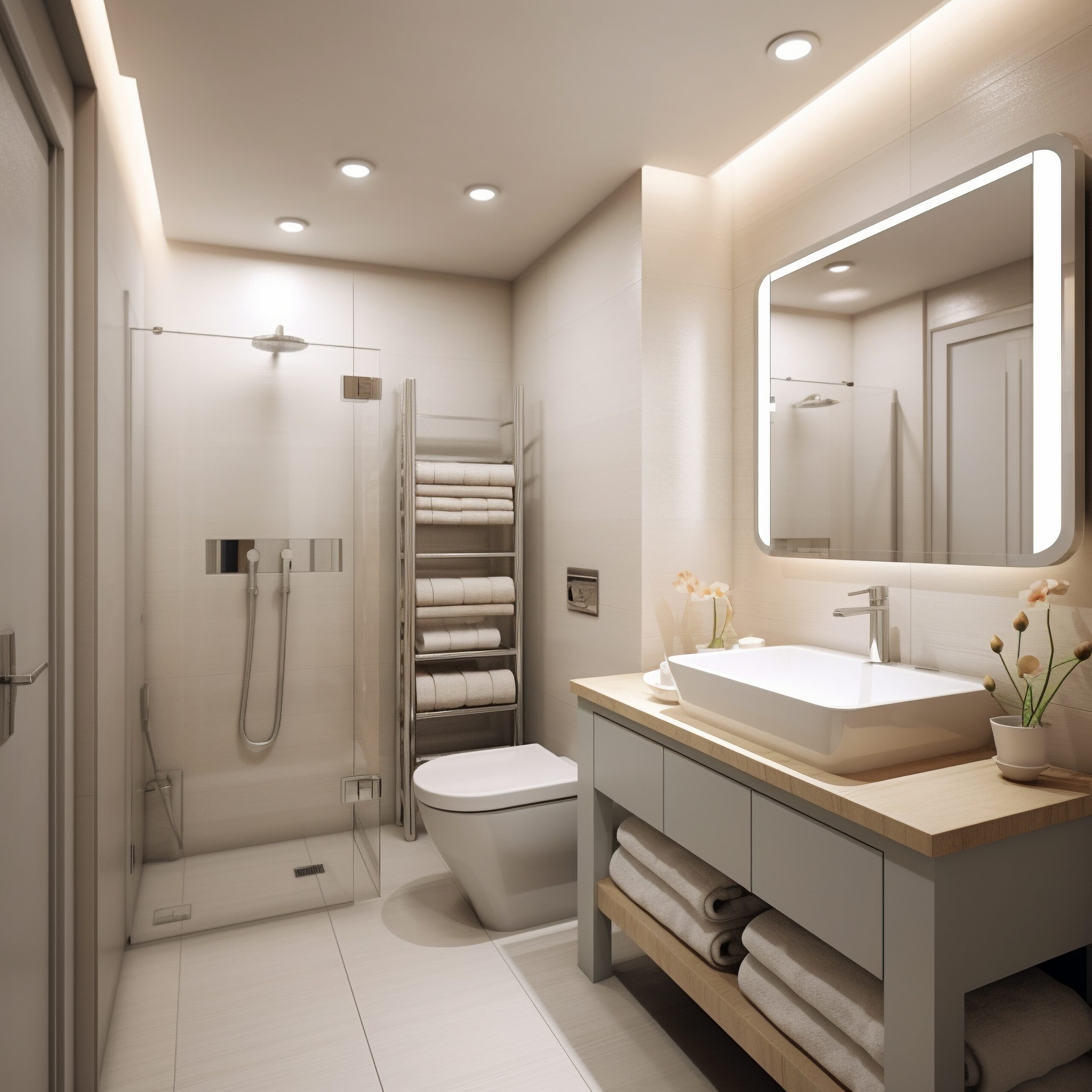Designing an Aging-in-Place Bathroom Without Sacrificing Style
Create a safe, accessible bathroom that grows with you while maintaining the elegance and sophistication you love.
At Golden Hammer Remodeling, we understand that planning for the future doesn’t mean compromising on style today. Aging-in-place bathroom design has evolved far beyond institutional-looking grab bars and clinical aesthetics. Today’s accessible bathrooms seamlessly blend safety features with sophisticated design elements, creating spaces that are both beautiful and functional for users of all ages and abilities. Whether you’re proactively planning for your golden years or adapting your Newton home for a family member with mobility challenges, thoughtful design can create a bathroom that feels luxurious while providing the accessibility features you need.
The key to successful aging-in-place design lies in understanding that accessibility and style are not mutually exclusive. With careful planning and the right design choices, your bathroom can be a stunning retreat that happens to include features that make daily routines safer and more comfortable as you age.

1. Universal Design Principles That Enhance Beauty
Universal design principles form the foundation of any successful aging-in-place bathroom, but these guidelines can actually enhance rather than detract from your bathroom’s aesthetic appeal.
Wide doorways and clear floor space don’t just accommodate wheelchairs and walkers—they create an open, spacious feeling that makes any bathroom feel more luxurious. At Golden Hammer Remodeling, we recommend 36-inch doorways and turning spaces of at least 60 inches in diameter. These generous proportions create a sense of grandeur that rivals high-end hotel bathrooms.
Lever-style door handles and faucets are easier to operate than traditional knobs, but they also offer a sleek, contemporary look that elevates your bathroom’s design. Similarly, rocker-style light switches provide a modern aesthetic while being easier to operate with limited dexterity.
The principle of “one-level living” can be beautifully implemented through curbless shower designs that create seamless transitions between spaces. These barrier-free showers not only eliminate tripping hazards but also create visual continuity that makes your bathroom appear larger and more sophisticated.

2. Stylish Safety Features That Don’t Look Medical
The biggest misconception about aging-in-place design is that safety features must look institutional. Today’s manufacturers offer grab bars, shower seats, and other accessibility features in finishes and styles that complement any design aesthetic.
Grab bars are now available in oil-rubbed bronze, brushed gold, matte black, and countless other finishes that can match your existing fixtures. At Golden Hammer Remodeling, we often specify decorative grab bars that double as towel bars or toilet paper holders, seamlessly integrating safety into the overall design. Vertical grab bars can be designed to look like architectural elements, while horizontal bars can appear to be intentional design features.
Shower benches and seats have evolved from basic plastic accessories to beautiful built-in features crafted from natural stone, teak, or tile that matches your shower walls. A well-designed shower bench can serve as a design focal point while providing a safe place to sit during bathing.
Non-slip flooring no longer means sacrificing style for safety. Modern textured tiles, natural stone with honed finishes, and slip-resistant luxury vinyl planks offer excellent traction while maintaining sophisticated appearances. We often recommend larger format tiles with minimal grout lines for easier cleaning and a more seamless look.

3. Smart Storage Solutions for Accessibility
Accessible storage doesn’t mean everything must be at counter height. Strategic storage planning can actually improve your bathroom’s organization while ensuring frequently used items remain within easy reach.
Pull-down shelving systems allow you to store items at various heights while bringing them down to a comfortable level when needed. These systems work particularly well in medicine cabinets and linen closets, maintaining clean lines while maximizing accessibility.
Drawer-style vanities offer easier access than traditional cabinets with doors, and they can be designed with varying heights to accommodate different users. At Golden Hammer Remodeling, we often design vanities with a combination of standard-height and seated-height sections, creating visual interest while serving multiple users.
Open shelving can provide easy access to frequently used items while creating opportunities for decorative display. Floating shelves at various heights can accommodate different users while adding architectural interest to your bathroom walls.
Consider incorporating pull-out organizers, lazy Susans, and other adaptive storage solutions that make accessing items easier while keeping your bathroom clutter-free and visually appealing.
4. Lighting Design for Safety and Ambiance
Proper lighting becomes increasingly important as we age, but good lighting design also enhances the beauty and functionality of any bathroom.
Layered lighting approaches work best for aging-in-place bathrooms. Ambient lighting provides overall illumination, task lighting focuses on specific activities like grooming, and accent lighting creates visual interest and depth. This multi-layered approach ensures adequate light levels while creating a sophisticated atmosphere.
Motion-sensor lighting can provide safety benefits by automatically illuminating pathways during nighttime visits, but these systems can be designed to be virtually invisible during the day. Under-cabinet lighting, toe-kick lighting, and recessed floor lights can guide movement safely while adding dramatic design elements.
Dimmer controls allow you to adjust lighting levels throughout the day, providing bright task lighting when needed and softer ambient lighting for relaxation. Smart lighting systems can be programmed to gradually increase brightness in the morning and dim in the evening, supporting natural circadian rhythms.

5. Flooring and Surface Choices That Combine Safety with Style
The right flooring and surface materials can provide safety benefits while contributing to your bathroom’s overall aesthetic appeal.
Natural stone with honed or textured finishes offers excellent slip resistance while maintaining the luxury appeal of marble or granite. Limestone, travertine, and slate can all be treated to provide safe surfaces without sacrificing their natural beauty.
Large-format porcelain tiles with subtle textures provide slip resistance while creating clean, contemporary looks. These tiles can mimic natural materials like wood or stone while offering superior durability and easier maintenance.
For shower areas, smaller mosaic tiles naturally provide more grout lines for traction, and they can be arranged in beautiful patterns that become design focal points. Penny tiles, hexagonal mosaics, and linear patterns can all provide safety while adding visual interest.
Luxury vinyl planks designed to look like hardwood can provide warmth and comfort underfoot while offering excellent slip resistance and water resistance. These materials have evolved to closely mimic natural wood grain and can create spa-like atmospheres.
6. Technology Integration for Enhanced Independence
Smart home technology can significantly enhance bathroom safety and convenience while maintaining clean, uncluttered aesthetics.
Voice-controlled lighting, ventilation, and even water temperature can eliminate the need to reach for switches or controls. These systems can be integrated invisibly into your bathroom design while providing hands-free operation that becomes increasingly valuable over time.
Smart mirrors with built-in lighting, defogging capabilities, and even health monitoring features can replace traditional mirrors while adding high-tech functionality. Some models include medication reminders, weather updates, and other helpful information.
Heated floors provide comfort and safety by eliminating cold surfaces that can cause slips, while also adding a luxury amenity that enhances your daily routine. Radiant floor heating systems can be controlled via smartphone apps for ultimate convenience.

At Golden Hammer Remodeling, we believe that aging-in-place design represents the future of bathroom remodeling. By incorporating accessibility features from the beginning, you create a bathroom that will serve you beautifully for decades to come. Our approach focuses on timeless design elements that happen to include safety features, rather than medical-looking additions that compromise your home’s aesthetic appeal. The result is a bathroom that feels like a luxury retreat while providing the practical benefits you need for safe, independent living.
Ready to start your aging-in-place bathroom project? Contact Golden Hammer Remodeling today for a consultation. Our experienced design team specializes in creating beautiful, accessible bathrooms that enhance both your home’s value and your quality of life. We’ll work with you to develop a design that meets your current needs while planning for the future, ensuring your bathroom remains a source of comfort and pride for years to come.
Frequently Asked Questions (FAQ)
1. How much does an aging-in-place bathroom remodel typically cost in the Boston area?
2. Can aging-in-place features be added to historic homes in Newton, Lexington, or other Boston suburbs?
3. What's the difference between ADA compliance and aging-in-place design?
4. How do I know which accessibility features I should include now versus later?
5. Will aging-in-place features affect my home's resale value?
6. Can I make my bathroom more accessible without a full renovation?
7. How do I maintain the spa-like feel while adding safety features?
Blog
Looking for more insights? Explore our blog for expert tips, in-depth guides, and the latest trends.
Keep discovering more content to help you stay ahead!
